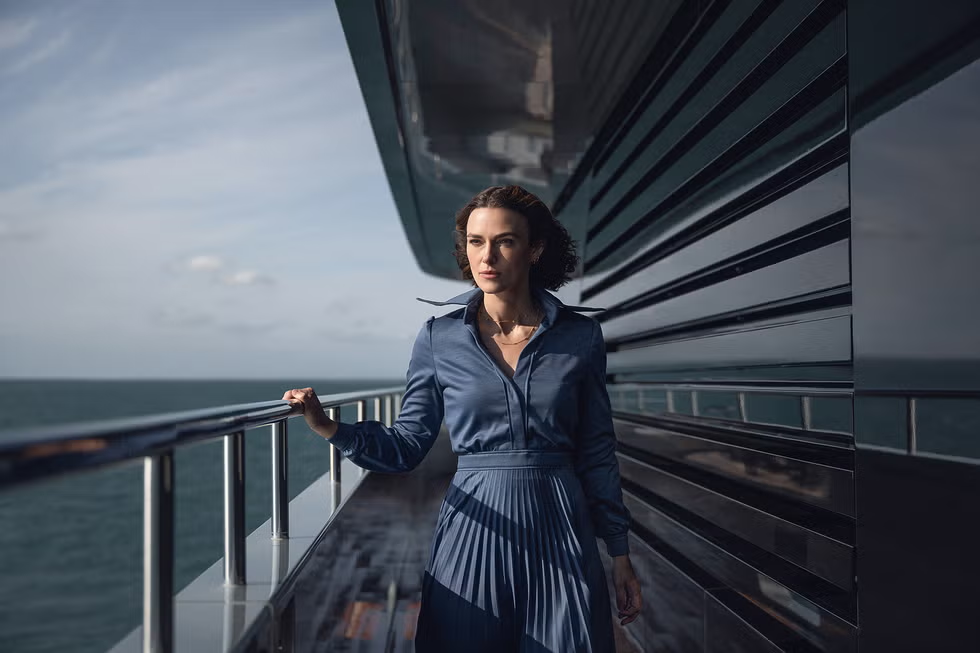
A luxury cruise through the serene Norwegian fjords promises opulence, tranquility, and breathtaking views—an assignment any travel journalist would dream of. But for Laura “Lo” Blacklock, portrayed by the inimitable Keira Knightley, this voyage aboard the elite Aurora transforms into a nightmare of paranoia, deception, and betrayal. Netflix’s upcoming psychological thriller, The Woman in Cabin 10, set to premiere on October 10, 2025, plunges viewers into a claustrophobic world where truth is elusive, and danger lurks behind every polished surface. Adapted from Ruth Ware’s bestselling 2016 novel, this film promises to keep audiences on the edge of their seats, questioning reality alongside its embattled protagonist.
Lo Blacklock is a journalist at a crossroads, grappling with personal struggles and a career that demands she seize every opportunity. When she’s assigned to cover the maiden voyage of the Aurora, a boutique luxury yacht catering to the ultra-wealthy, it feels like a chance to prove herself. The ship is a floating palace—elegant dining rooms, sleek corridors, and lavish cabins exude sophistication, set against the stark beauty of the North Sea. But the idyllic setting belies a sinister undercurrent. Late one night, Lo is jolted awake by a scream and a sickening splash. Peering from her cabin, she witnesses a figure being thrown overboard into the dark, churning waters. Her heart races as she reports the incident, only to be met with disbelief: all passengers and crew are accounted for. The ship’s records show no one is missing, and her claims are dismissed as a product of exhaustion or imagination.
What follows is a descent into a psychological maelstrom. Lo, driven by a mix of determination and doubt, refuses to let the matter rest. Her journalistic instincts kick in, compelling her to investigate despite the mounting skepticism from those around her. The ship, once a symbol of luxury, becomes a gilded prison, its confined spaces amplifying her sense of isolation. Every interaction is laced with suspicion—every glance, every whispered conversation seems to conceal a secret. The crew and passengers, a glittering ensemble of the elite, close ranks, leaving Lo to question not only what she saw but her own sanity. Was there really a body? Or is she unraveling under the weight of her own unresolved trauma?
The film’s strength lies in its ability to weave a tightly knit web of tension. The Aurora’s opulent interiors contrast sharply with the cold, unforgiving sea outside, creating a visual metaphor for the duality of appearances versus reality. Lo’s journey is not just a quest for truth but a battle against a society that dismisses her because of who she is—a woman, a journalist, someone perceived as unreliable. This theme, resonant in today’s world, underscores the narrative, making Lo’s struggle deeply personal yet universally relatable. Her determination to uncover the truth, even at the cost of her own safety, transforms her from a passive observer into a relentless force, navigating a maze of lies and half-truths.
Keira Knightley, known for her commanding performances in films like Pride & Prejudice and The Imitation Game, brings a raw intensity to Lo. Her ability to convey both vulnerability and steely resolve makes her the perfect anchor for this psychological thriller. Knightley’s portrayal captures the nuances of Lo’s emotional rollercoaster—moments of paralyzing doubt give way to flashes of defiance as she pieces together clues that others refuse to see. The actress’s experience with complex characters shines through, as she balances Lo’s growing paranoia with a fierce intelligence that keeps viewers rooting for her.

The supporting cast is a powerhouse, adding layers of intrigue to the story. Guy Pearce, with his chameleonic ability to embody both charm and menace, plays a pivotal role that keeps audiences guessing. Hannah Waddingham, fresh from her Emmy-winning turn in Ted Lasso, brings a commanding presence, while David Ajala and Kaya Scodelario infuse their characters with enigmatic depth. The ensemble, rounded out by talents like Gugu Mbatha-Raw, David Morrissey, and Art Malik, creates a tapestry of potential allies and adversaries, each interaction fraught with ambiguity. Director Simon Stone, known for his work on The Dig, masterfully orchestrates this cast, using the ship’s confined setting to heighten the sense of claustrophobia and mistrust.
The screenplay, co-written by Stone, Joe Shrapnel, and Anna Waterhouse, stays true to the spirit of Ware’s novel while amplifying its cinematic potential. The film delves into the psychological toll of being disbelieved, a theme that resonates deeply in an era where truth is often contested. Stone’s direction emphasizes the ship’s dual nature—its luxurious facade hiding darker truths beneath. The cinematography, with its interplay of warm interiors and stark seascapes, mirrors Lo’s internal conflict, while the score builds an atmosphere of unrelenting suspense. Every creak of the ship, every shadow in the corridor, becomes a potential threat, pulling viewers deeper into Lo’s fractured reality.
As Lo digs deeper, she uncovers hints of a larger conspiracy. The passenger she saw—or believes she saw—may be tied to secrets that powerful forces aboard the Aurora are desperate to keep hidden. The film’s pacing builds relentlessly, with each revelation tightening the noose around Lo’s investigation. Twists unravel in unexpected ways, challenging assumptions and keeping audiences guessing until the final frame. The narrative toys with the idea of the unreliable narrator, forcing viewers to question whether Lo’s perceptions are trustworthy or if she’s being manipulated by a mastermind lurking in plain sight.
The production itself was a feat, filmed on a real superyacht named Savannah, which stands in for the fictional Aurora. Additional shooting in locations like Scotland and Norway adds a haunting beauty to the film, with the rugged coastlines and icy waters serving as a stark reminder of the isolation at the story’s heart. The logistics of filming on a $150 million yacht required meticulous planning, with the crew navigating tight spaces and respecting the vessel’s pristine condition. These challenges only enhance the film’s authenticity, immersing viewers in the same confined, luxurious world that traps Lo.
The Woman in Cabin 10 is more than a thriller—it’s a meditation on truth, perception, and the courage to stand firm in the face of doubt. It taps into primal fears of being unheard, unseen, and unbelieved, while delivering the pulse-pounding suspense that fans of the genre crave. As the release date approaches, anticipation builds for a film that promises to be a standout in Netflix’s 2025 slate. Will Lo uncover the truth before it’s too late, or will the sea swallow her secrets forever? One thing is certain: this is one cruise you won’t want to miss.



